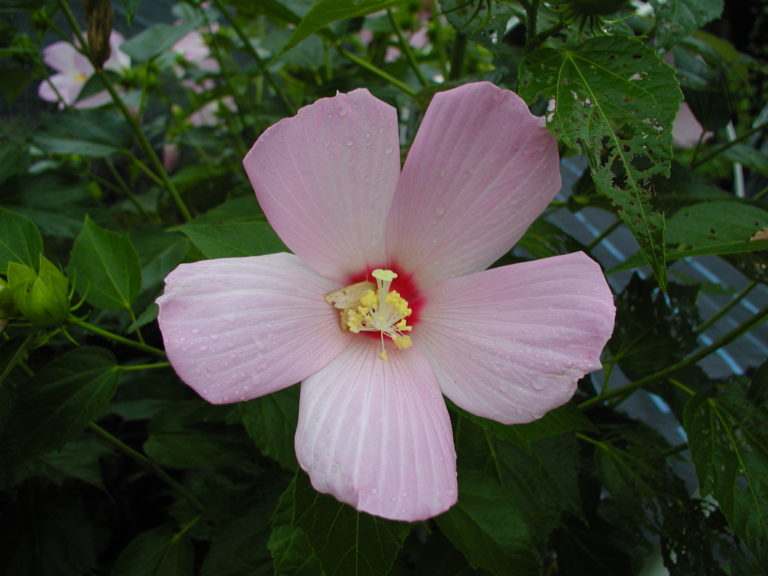Crimson-eyed Rosemallow is a robust wetland herbaceous perennial native to most of Eastern North America up to New York. It is shrub-like, with multiple, unbranched stems 3-7′ in height. Large, single flowers occur in upper leaf axils, with delicate petals ranging from white to pink but always with a maroon “eye”. Individual flowers are only open a single day, but they continue to open daily for a long season and are followed by attractive seed capsules. Crimson-eyed Rosemallow grows well in full sun to partial shade and in soils ranging from upland garden soil to very wet. It can be pruned mid-season for a shorter flower display. It attracts long-tongued bees, hummingbirds and a variety of butterflies and moths to the garden.
NURSERY HOURS
Wednesday: 10-4 Thursday: 10-6 Friday-Saturday: 10-4 Sunday: 12-4
Hibiscus moscheutos ‘moscheutos’

Key Info
Scientific Name: Hibiscus moscheutos L. ssp. moscheutos
Common Names: Crimson-eyed Rosemallow, Marshmallow Hibiscus, Wild Cotton, Swamp Rosemallow, Eastern Rosemallow
Family Names: Malvaceae (Mallow Family)
Plant Type: Herbaceous perennial
Flower Color: White, Pink/rose
Special Characteristics: Attracts bees, Long blooming period, Attracts butterflies, Reported to be deer resistant., Attracts Hummingbirds, Tolerates wet conditions
Additional Info
Habit: Crimson-eyed Rosemallow has many smooth, round, sturdy, upright, unbranched stems emerging from a central woody crown (no basal rosette); this plant has a short underground caudex with large storage roots attached. Foliage texture is coarse.
Height: 3' to 6'
Spread: 4'
Soil Conditions: Average to wet, acid to circumneutral pH, sandy, loamy and clay soils.
Leaves: Alternately arranged, greyish green, 3-8-inch long x 4 inches wide, leaves with long, slender petioles, reddish veins, white undersides and toothed margins; ovate with pointy tip, either unlobed or with two pointed lobes. Leaf pubescence is variable across plants, but lower surface is more likely pubescent.
Flowers (or reproductive structures: The perfect flowers have five delicate petals 3-4 inches long and wide, white or pink with deep red at the base, widest at the flattish and slightly wavy tips. The prominent stamen column consists of a number of filaments fused into a single tube with multiple anthers along its length, surrounding a pistil of five fused styles which branch out to present the five stigmas. The flower is subtended by a beautiful row of 5 sepals and a row of linear bracts.
Fruit: The sepals of the flowers develop into a rounded, green 5-chambered seed pod which ripens into a brown, papery, short- beaked capsule which opens to release many small brown seeds, August to October.
Natural Distribution: Found near ponds and lakes, along rivers and streams, wet pastures and roadside ditches; also,.marshes and wetlands and salt scrub habitats.
USDA Hardiness Zone: 5 to 9
USDA Wetland Indicator Status in NC: OBL
Pollination: Bees of various types.
Wildlife Connections: Attracts hummingbirds, butterflies, and bumble bees, specifically Rose Mallow Bee; Northern bobwhites, blue-winged teals, pintails, and wood ducks consume crimsoneyed rosemallow seeds; red-winged blackbirds nest in common rosemallow (FEIS database)
Propagation: Crimson-eyed Rosemallow grows easily from seed. However, insect seed predators will conslume many of the seeds, which should therefore be collected as soon as the capsule opens.
